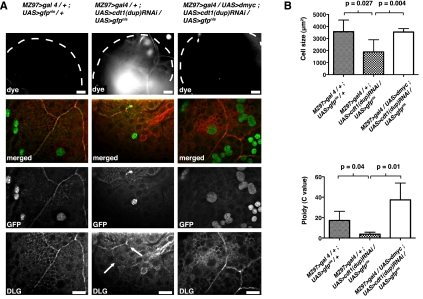Figure 4.
Polyploidy is necessary for a functional blood–brain barrier. (A) Dye penetration was observed in MZ97>gal4/+;UAS>cdt1(dup)RNAi/UAS>gfpnls, but this defect was rescued by overexpression of dmyc in MZ97>gal4/UAS>dmyc;UAS>cdt1(dup)RNAi/UAS>gfpnls animals. The abrogated septate junctions also were rescued by dmyc induction in the SPG. The wild-type DLG pattern is shown in third instar larval brain from MZ97>gal4(II)/+;UAS>gfpnls/+ controls. This pattern was disrupted (arrows) when replication was blocked in MZ97>gal4/+;UAS>cdt1(dup)RNAi/UAS-gfpnls. and dmyc induction restored the Dlg pattern in MZ97>gal4/UAS>dmyc;UAS>cdt1(dup)RNAi/UAS>gfpnls to the same pattern as in the control. GFP signal marks SPG nuclei. Bars, 10 μm. (B) Reduction in SPG cell size and ploidy after ablation of cdt1(dup) [MZ97>gal4/+;UAS>cdt1(dup)RNAi/UAS>gfpnls] compared with control (MZ97>gal4/+;UAS>gfpnls/+). Cell size and ploidy were rescued to control levels by dmyc overexpression [MZ97>gal4(II)/UAS>dmyc;UAS>cdt1(dup)RNAi/UAS>gfpnls]. The probabilities of significant differences between the samples are shown.

